The forest department staff was actively involved in the rescue and relief operations in flood-hit Kerala.
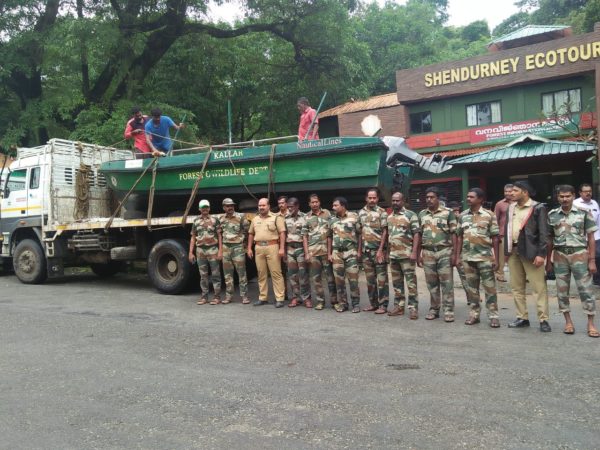
Kerala Forest Department Staff © Kerala Forest Department
The Kollam Shenkotta road was blocked by huge trees that had fallen across it. Clearing it took a few hours and many hands from the department working with the PWD teams.
The normally peaceful Achenkoil river was in spate and people on the other side could not dream of ferrying across. The staff managed to get a rope tied to a tree on the other side and send essentials along the rope. This was also done at Konni where a tribal colony at Avanipaara had been isolated.

Bimmaram Tribal colony in Ranni Range was dislocated during the flood. Forest Department staff of Ranni Range took care of all the families including new born kid. © Kerala Forest Department
Searching for survivors of landslides in Wayanad, Idukki and Munnar, working with the police and revenue department, the staff was pressed into the rescue operations.
In Nelliampathy (Palakkad district) the department staff carried elderly people and walked for 9 kms through tough paths to bring them outside the isolated village in the hill station.
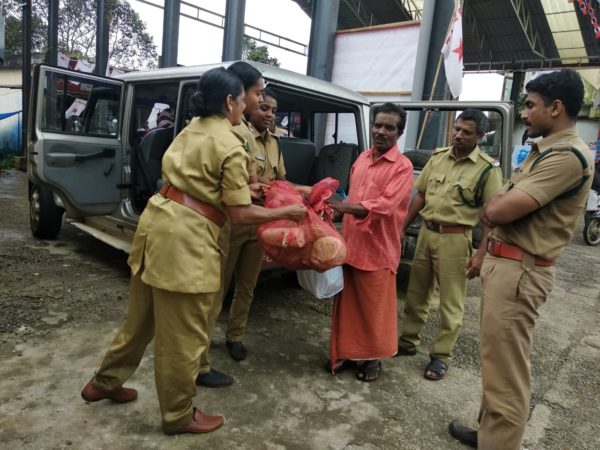
Kerala Forest Department staff distributing supplies © Kerala Forest Department
With coracles belonging to the ecotourism wing, the teams rowed along submerged lanes of towns in Pattanamthitta, rescuing people stuck on the second floor and terraces of houses. More than 600 people were rescued in this district alone.
Rescuing tribals stuck in many hilly regions of the state, bringing them to relief camps and taking care of them, the Kerala Forest Department has been actively involved in the rescue and relief operations in flood-ravaged Kerala. Building makeshift bridges using wooden logs and planks the staff helped those isolated to cross the gushing rivers. Sometimes the rescued people had to be guided across very slippery or difficult terrain.
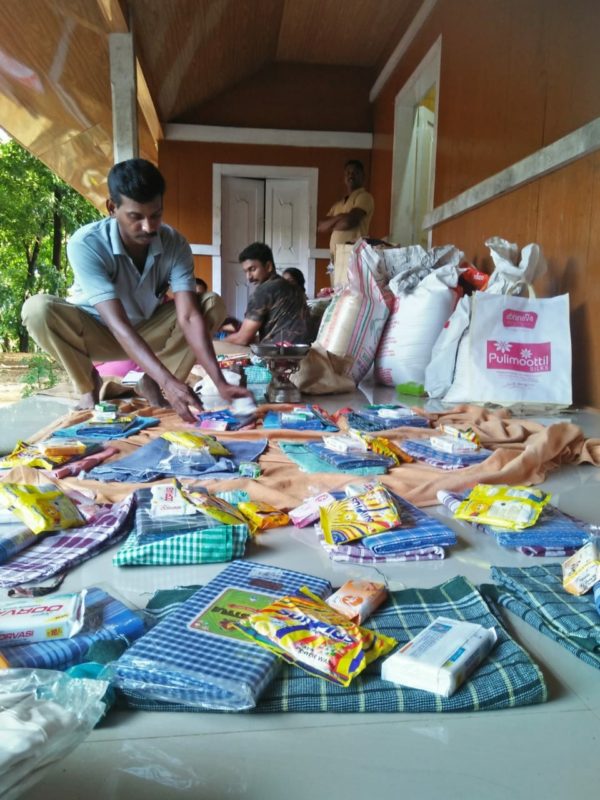
© Kerala Forest Department
Many of the forest station buildings were operating as relief camps. While 24 camps were fully managed by the KFD, they were involved in the running of 50 other camps along with other departments. Besides rescuing over 2000 people, around 5000 people were staying in the relief camps run by the department.
The Kerala forest department has now appointed special teams for relief work beginning Thursday. Cleaning houses, wells, water sources, removing garbage and carcasses of animals, the team comprising a total of 2000 of the staff (watchers, VSS eco-development committee members and others) will be directed by the DFOs and RFOs. Each team will have five members. The hilly regions and Aluva, Changannur, Chalakkudy will get priority while some regions like Arippa and Valayar will have special committees. In some parts like Vazhachal division the cleaning has already begun, said Mr P K Kesavan, the PCCF and HoFF, who has instructed his officers on the cleaning mission.
The floods and landslides have mostly been witnessed in forested and mountainous areas of the state where the forest department are most equipped as it is its home terrain. The divisional forest officers, range officers and staff have all been involved in the rescue and relief works. Around 100 of the department vehicles have been pressed into flood relief work. Jeeps, coracles and speed boats got into the act. In places like Shendurney and Peechi, hundreds were rescued using speed boats. In Konni alone, using the more basic coracles, the department rescued around 1500 people from isolated areas.
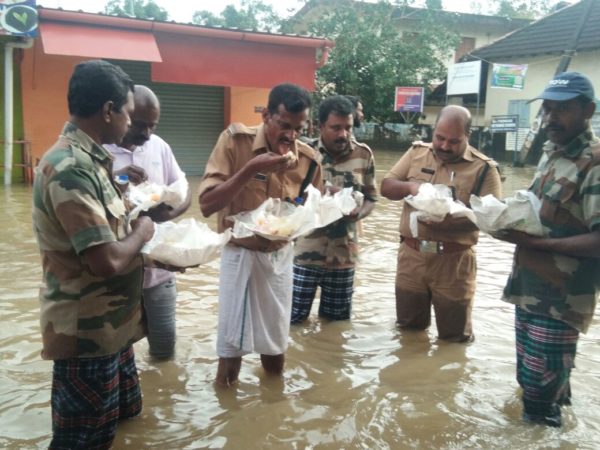
Enjoying a meal! © Kerala Forest Department
Wildlife casualties
According to the forest officials, there have not been many casualties of wildlife. One tiger death in Thekkady, a young male elephant fatality in Puthanpara, and two gaur deaths in Kozhikode and Nilambur, have been reported so far. “We will know the full picture only after the perambulation that will be completed in 1-2 weeks, but we are not expecting too many deaths,” said Shivprasad, the ACF Control Room. In fact, the department could also rescue two elephant calves and send them back to their herd, he said.
Right now in the central zone which was the most affected, the field staff and families are themselves in relief camps and only after they return back to duty will a detailed report be ready, he said.

© Kerala Forest Department
Of roads, rivers and people
In the south, the main road from Thenmala, Kottavasil and Achankoil which was cut off by landslide was made motorable by small vehicles, thanks to the efforts of the forest department staff. The 50 families shifted to Achenkoil government school was taken care by the department staff that supplied food, water and medicine.
The Ariyankavu Kotavasal road damaged by landslide has also seen the department working with other departments to restore it. Two relief camps were run by the FD in Ariyenkavu and Thenmala ranges with the ecotourism guides pitching in.
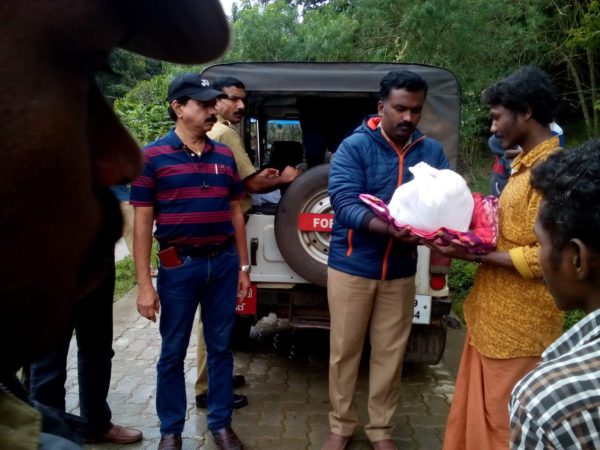
© Kerala Forest Department
In Punalur division of Pathanapuram range, urban areas were flooded and a relief camp was opened and department vehicles used in rescue operations. In Konni town that was flooded the forest station was cut off . The staff were safe. At Ranni and Kozhenjerry the ecotourism guides of the department pitched in to rescue hundreds. Tribal colonies on banks of the swollen Pamba river were shifted even while the forest station was isolated.
In the Thrissur division people were safely removed from forested areas of Kaliyar, Velladi, Mannathipara to the relief centres while in Akamala, they were removed from Cheppilakode area to safer areas. In Vazhachal division, the staff was involved in rescue and clearing operations following landslide. The Kuzhancherry landslide spot saw KFD staff working to rescue people and restore roads, as also in the Pattikad range. The tribal school in Neyyar wildlife sanctuary was operating as a flood relief camp where 46 families were sheltered.
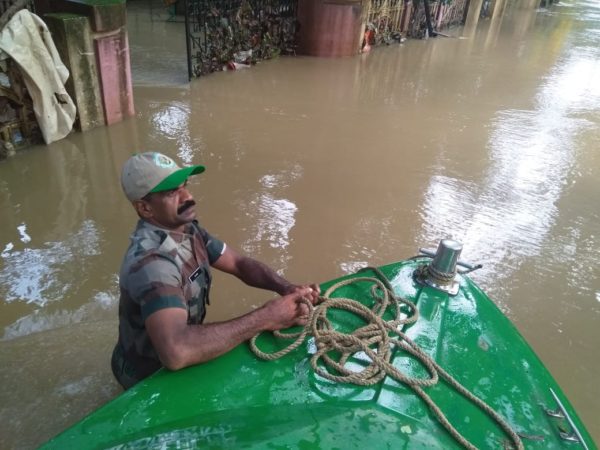
© Kerala Forest Department
In Wayanad, those living in landslide prone areas were shifted as a precautionary measure. The tribes found in Wayanad, Idukki, Pattanamthitta, Thiruvalla and other places were either moved to safe locations or helped with essentials. The department worked to clear the roads to Nelliyampathy in Palakkad district, a hill station that was cut off due to landslides and fallen trees.
The role of the forest department in helping Adivasis and others during the floods has not been noticed as much as that of the armed forces, perhaps because the department is mostly operating in the forest fringe areas.
Some of the staff themselves had to be rescued from interior remote regions, many of which are landslide prone areas. Fortunately, there have been no casualties. In the Silent Valley which saw many landslides, it was difficult reaching the staff as bridges had collapsed in parts. But again, luckily the staff were evacuated, said Shivprasad.
Hopefully, the worst is over.